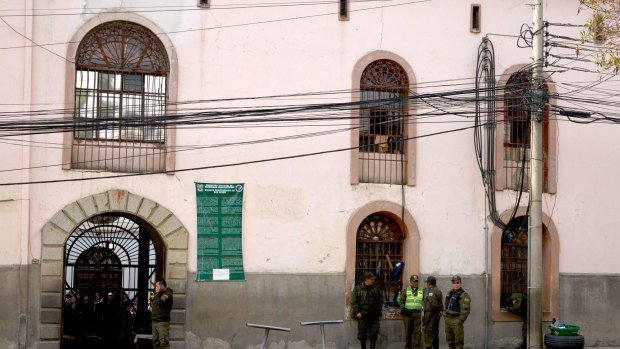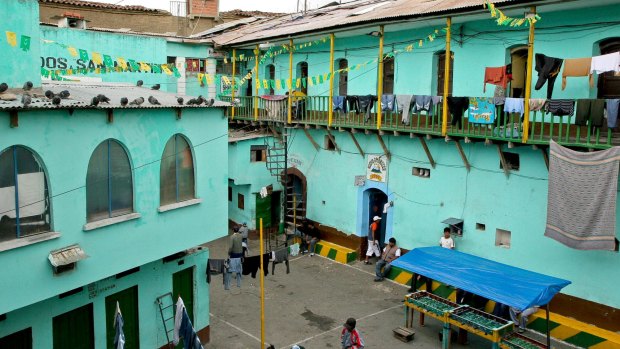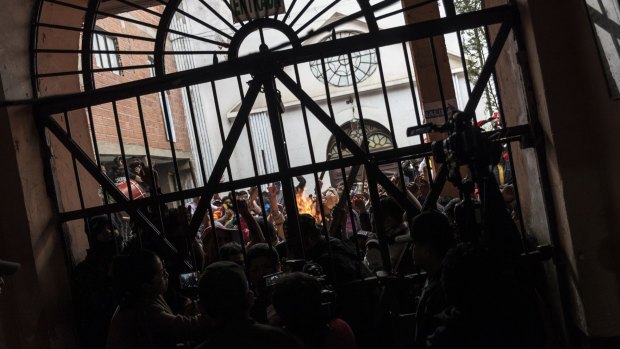This was published 1 year ago
San Pedro prison, La Paz: I did a 'tour' of Bolivia's notorious cocaine prison
By Steve Madgwick

In the '90s, it was quite common for backpackers to take an unofficial tour of La Paz's notorious San Pedro prison.Credit: Alamy
A quaking hand unclenches to reveal a rock of base cocaine the size and texture of a hefty summer hailstone retrieved from a muddy gutter. My stupid life flashes before my stupid eyes for the first of two times in rapid-fire succession.
He rubs his thumb and forefinger together, mumbles "US dollars" in gravelly Spanglish, then thrusts the rock towards my face, expecting an offer on his unsolicited merchandise. Surely only a moron would buy a convictable quantity of cocaine within the confines of a South American prison?
My fellow backpackers on today's unofficial tour of San Pedro (male) prison in the Bolivian capital of La Paz have skipped ahead, leaving me cornered in Manic Coke Cook's cell. His eyes move independently of each other, un-soothed by sleep for days; his teeth just serrated, brown debris. Undoubtedly, he has broken the drug trade's Golden Rule: Don't take what you make.

Prisoners' families live with them in San Pedro and some parts of the prison are much nicer than others.Credit: Alamy
Unfortunately, my Spanish does not extend to "No, Señor, as robust as your product seems, I will not be buying drugs while I am effectively locked inside this prison today. Muchas Gracias."
I disengage eye contact(s), shuffle past him, head bowed, and fall into an awkward canter to catch my burly Bolivian tour guide and his two equally burly goons. Crisis averted and life-flash quelled, sub-normality resumes. A few minutes later, a firm finger pecks at my shoulder.
"Hey, Steve, look what I got," says my travel companion. "Only 50 bucks!" His fist unclenches, revealing the aforementioned illicit rock. Fifty sets of eyes surreptitiously note his purchase and connect the dots that we are, in fact, together.

Prisoners during a protest over conditions in 2019.Credit: Getty Images
Ostensibly, we are 'together', kindred souls on South America's backpacker 'Gringo Trail', who met on a bus a few days ago (I didn't even know his surname at the time). We also handed over our passports to the guards as we entered El penal de San Pedro together. Reading the terror on my twitching, flush-mottled face, Unnamed Friend tries to placate me.
"Don't worry, if anything happens, I'll pretend I don't know you," he says.
No worries, I'm sure the corrupt judge will understand.
The tour ends 30 excruciating, paranoia-filled minutes later. I trudge back to the front gate, feeling doomed to sign in rather than sign out. Strangely, however, after an obligatory US-customs-style double-take of my photo, the guard returns my precious passport and motions his head towards freedom. I skip out the door, with a new appreciation for La Paz's rarefied light, Unnamed Friend following a minute or two later…
How did I end up in San Pedro? It began innocently enough, a hand-written note on a hostel noticeboard inviting backpackers to "visit an English prisoner in jail". Young, dumb and full of, um, bravado, it seemed like a natural, normal progression on my three-month South American odyssey. A journey that started with more conventional experiences, like hiking Peru's Machu Picchu and a storm-aborted attempt to summit Mount Cotopaxi, Ecuador.
San Pedro may sound strangely familiar to you. You would definitely know it if you backpacked around South America around the late 1990s onwards. Conversely, you could have read Marching Powder: A True Story of Friendship, Cocaine, and South America's Strangest Jail.
The cult book, written by Australian author Rusty Young, chronicles the story of the prison's best-known inmate, convicted English cocaine smuggler Thomas McFadden. Young bribed his way into San Pedro, staying months to get the story of the man who started the tours. It would have been good to read Marching Powder beforehand, to know that my experience was in fact a pretty normal day in this most abnormal of places, but the book was published five years after my 1998 visit.
Getting behind San Pedro's 15-metre stone walls was a simple enough matter back then. Ask for Thomas at the front gate, hand over your passport to the guards, then back-hand $US5 to your prisoner guide, who presumedly gave a cut to the guards – who did not escort tours.
Unnervingly, I was met by a burly English-speaking Bolivian prisoner who told us "Thomas doesn't do the tours anymore" (he was, as it turned out, just not on that day). He never mentioned Thomas again and stayed shtum about his own crimes (apparently three-quarters of San Pedro inmates are inside for smuggling, producing or selling one of Bolivia's biggest exports).
The memory of Manic Coke Cook is burned into my brain, but just about everything else that day seems implausibly surreal two decades later. The fact that drugs were being mass-produced was not even the most interesting thing about the 'minimum-security' dystopian shanty jail.
For starters, the only guards I saw were on the perimeter, seemingly employed just to stop escapes or quash full-blown riots. Once inside, a prisoner-hierarchy controlled San Pedro; a place which was built to house a few hundred prisoners but held several thousand, at a guess, when I was there.
Famously, prisoners could buy their way into San Pedro's better 'neighbourhoods'. I remember clearly how some cells were substantially plusher than the hotels and homestays I frequented at the time. Some featured carpets and decent furnishings, big TVs, en-suites and a few even sort of had city views. One prisoner even added an extension to his cell, so the legend goes. Pitifully basic meals were supplied to prisoners but those with access to cash had a choice of 'restaurants' to dine in.
The biggest surprise, however, was who else lived inside San Pedro's walls: the prisoners' wives and children. Kids with little backpacks on would trot off to school on the outside each morning, returning through the gates in the afternoon. With its own economy, workshops and churches, San Pedro could almost feel like an ordinary – if not downtrodden – suburb of La Paz. However, perish any warm and fuzzy thoughts immediately.
Prisoners with no money or power suffered a particularly miserable existence; forced to sleep in squalor on cold concrete, more or less out in the open. La Paz is 3600 metres above sea level so temperatures plummet after dark.
The stories of La Piscina (the pool), a small concrete well in the courtyard, still haunt my dreams. The guide graphically recounted how paedophiles and rapists would be beaten and drowned there. Survivors might then be forced to live out their sentence in the kitchen. It's gotten worse recently, with reports of the death of a young girl and other crimes against non-prisoners.
Thomas McFadden was released years ago and San Pedro tours were officially banned after the prison became an international cause célèbre. Although rumours persist that you can still visit if you really want to.
At the peak, hundreds of visitors filed through San Pedro each week, often bearing food, medicine and clothes for the prisoners (including my green Hoodoo Gurus T-shirt). Some ballsy backpackers even reportedly stayed overnight to party with prisoners – after all, coke was much cheaper to buy inside than out.
Today, the idea of visiting a convicted drug smuggler in a foreign jail seems a paragon of stupidity, and memories from that day still stir my stomach butterflies. But with well-aged hindsight, I'm glad I ventured well beyond my comfort zone into the cocaine prison.
San Pedro honed my fight-or-flight response, and educated this sheltered suburban boy about the inequities of both a developing society like Bolivia's and also America's sanctimonious 'War on Drugs'. Yet my inner fraidy-cat still counts his lucky stars every day that he didn't become yet another flawed character in Marching Powder.
Sign up for the Traveller Deals newsletter
Get exclusive travel deals delivered straight to your inbox. Sign up now.